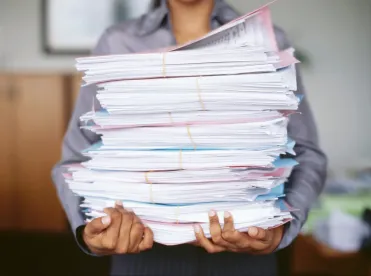The federal judiciary has proposed amending the Federal Rules of Evidence (FRE) by abrogating Rule 803(16) regarding the “ancient documents” exception to the hearsay rule (the Rule).
Briefly, FRE Rule 801(c) defines hearsay as “a statement that (1) the declarant does not make while testifying at the current trial or hearing and (2) a party offers in evidence to prove the truth of the matter asserted in the statement.” FRE 802 The Rule Against Hearsay provides that such a statement is not admissible as evidence unless the statement falls into one of the many exceptions to the hearsay rule detailed in the FRE. The ancient document exception set out in the Rule provides one such exception.
Text and Origin of the Ancient Document Exception
Rule 803(16) currently provides that a “statement in a document that is at least 20 years old and whose authenticity is established” is not excluded by the hearsay rule. FRE Rule 901(b)(8) provides a method for authenticating such a document when there is “evidence that it: (A) is in a condition that creates no suspicion about its authenticity; (B) was in a place where, if authentic, it would likely be; and (C) is at least 20 years old when offered.”
By way of background, the common law traditionally allowed for authenticating certain documents based on their age on the theory that “old” documents were inherently reliable when they are found in a place where they should be located. The common law ancient document exception embodied in the Rule was originally devised in the mid-1700s to support real estate matters, on the theory that real estate documents more than 40 years old, such as deeds, easements and the like, that were found where they should be found had an inherent measure of authenticity to them. Over time this concept, as embodied in the 20-year threshold of the Rule, evolved and was expanded to address the admissibility of documents used in any area of law where factual issues underlying the causes of action may be decades or more old. In addition to its original purpose in real estate transactions, the Rule currently impacts many areas of law with long-tail liability such as environmental pollution, toxic torts, sexual and child molestation, and contractual disputes. Notably, these types of matters also have corresponding insurance coverage implications.
The Proposed Rule Change
The draft proposed rule change, which was released for comment in August 2015, reads as follows:
Rule 803. Exceptions to the Rule against Hearsay −
Regardless of Whether the Declarant Is
Available as a Witness
The following are not excluded by the rule against hearsay, regardless of whether the declarant is available as a witness:
* * * * *
(16)
Statements in Ancient Documents. A statement in a document that is at least 20 years old and whose authenticity is established.[Abrogated (Effective Dec. 1, 2017).]
The comment period on the proposal closed in February 2016.
Impetus to Proposed Rule Change
The Judicial Conference Advisory Committee on Evidence Rules (the Committee) proposed the change because it anticipated an onslaught of requests to admit various types of electronic documents under the Rule, particularly since electronic storage of documents and data has been standard practice for approximately 20 years. The Committee was concerned that electronic data is not inherently reliable just because it is old; i.e., will we base future legal decisions on a 20-year-old Facebook post?
While acknowledging in its proposal that the common law traditionally allowed for authenticating documents based on age, the Committee found that it is relatively young by common law standards and lacked a longstanding tradition. The Committee argued that the exception remains only because it is seldom used; and then usually because no other evidence is available. While questioning the reliability of certain electronic data, such as archived social media, email and webpages, the Committee noted that the advent of long-term electronic data storage potentially makes more-reliable documents and data available to the parties.
At its heart, the proposal challenges the notion that a document is reliable simply because it is old. The current rule gives authenticity to a document that is 20 years old. What is it about a 20-year-old document that gives it an inherent air of reliability that was not inherent when the document was only 19 years old? Is this akin to laws that assume a person is mature enough to vote at 18 but not 17, or to drive at 17 but not 16?
Arguments to Keep the Rule
Opposition to the proposal has been fairly strong. Of the 208 comments filed during the comment period, 205 opposed the proposal. The majority of these comments came from practitioners who regularly use the Rule in their practice. While use of the Rule may not be common in general litigation, commenters argued that it is essential to their particular areas of practice.
Commenters argued that ancient documents properly admitted under the Rule have an independent air of reliability. For an ancient document to be admitted into evidence under the Rule, its proponent must demonstrate its inherent reliability, usually by showing that it was found “in a condition that creates no suspicion about its authenticity.” Rule 901(b)(8)(a). Proponents offering documents under the Rule often do so because the document is crucial to the matter at hand and no alternative is available. Moreover, authenticating ancient documents where no living person is available to authenticate same under any other exception, even if possible, can be very expensive, time consuming and thus ultimately prejudicial to their client.
Proponents of keeping the Rule pointed to sexual and child molestation cases where the alleged acts often happened decades prior. They argued that an abuse victim who either finally found the courage to speak up or was forced to speak up because of current circumstance would be victimized again because the authors of critical documents are either dead or nowhere to be found. Similarly, they pointed out that cases against accused Nazi war criminals, including attempts to return stolen property to their rightful owners, are built on Nazi records from the 1930s and 1940s. Other commenters made similar arguments for toxic tort cases. Frequently, the proof of plaintiff’s exposure, or lack thereof, may be contained solely in archived records since witnesses to events are long deceased, and thus documents admitted through the Rule may be the only alternative.
Proposed Alternatives
The Committee reviewed and ultimately rejected three alternatives to abrogation as unworkable. It considered (1) limiting the exception to hardcopy, (2) aligning it with Rule 807, the residual exception to the hearsay rule, and (3) adding a provision that a document would be excluded if an opponent could show it has a lack of trustworthiness. Notably, they rejected limiting the exception to hardcopy on the grounds that it is very difficult to distinguish between an original document and electronic copies. The Committee also rejected the second and third alternatives on the grounds that these would essentially turn the Rule into an unnecessary clone of the residual exception rule.
Several commentators acknowledged problems with the Rule and proposed revisions to address its shortcomings. A proposal extending the threshold period to 30 years was offered as way to give the judiciary a decade to develop a workable strategy and bring the federal Rule more in line with the original common law exception and the laws of many states. Another proposal was to formally require authentication as prescribed under Rule 901(b)(8). A third proposal would add language to the Rule to make clear that the exception only applies to hearsay statements made by the author of the document, not statements of others recounted in the document not otherwise allowed by FRE Rule 805, hearsay within hearsay.
Particular Implications for Long-Tail Injury Matters
If enacted, this rule change will likely have significant implications for so-called “long-tail” injury matters. Consider, for example, the potential financial implications in matters involving the remediation of our country’s most toxic sites. Liability disputes for environmental remediation and damages brought under the Comprehensive Environmental Response, Compensation, and Liability Act (CERCLA) or its state counterparts are fact-sensitive disputes often involving activities dating back decades, with many of these matters requiring the parties to establish operating processes and procedures employed by the company in question 50 years or more prior to the complaint.
In many cases, the only evidence tying these companies to astronomical liabilities is found in ancient documents. As one might expect, there may be no one alive to authenticate these records. Thus, both sides, by necessity, may rely on ancient documents in meeting their burden of proof: (1) the government or a private plaintiff in a cost recovery or contribution action, to establish a company’s liability and (2) the company to defend against these liability allegations. Under CERCLA, the federal government, ultimately we the people, pay the tab for remediation when responsible parties cannot be found. Indeed, commenters representing regulators and potentially liable parties seeking cost recovery or contribution objected to the change for these reasons.
In addition, hazardous waste, toxic tort and other long-tail liability matters invariably involve another layer − insurance coverage issues. A finding of coverage versus no coverage can change the complexion of these types of high-value litigation. Coverage determinations often are based on policies written and sometimes superseded or dropped decades ago. Importantly, in all these cases, it is the insured, not the insurer, who bears the burden of proving the existence and content of a disputed policy − a burden that, as a practical matter, they may be unable to carry without relying on the ancient document exception.
Takeaways
At this point, it is unclear whether the Judicial Committee will ultimately reject, adopt or modify the proposal. As noted above, however, abrogation of the Rule is likely to have significant economic ramifications that could be advantageous to certain parties that find themselves as defendants in environmental cost recovery or contribution suits as well as insurers defending against policyholder suits for coverage. Conversely, plaintiffs seeking cost recovery and contribution, toxic tort plaintiffs, and insurers seeking to prove exclusions using ancient documents may find that abrogation of the Rule significantly impairs their ability to do so.
An interesting outcome of the proposed abrogation is that a document could be authenticated under Rule 901(b)(8), which will remain, because of its ancient status but still be excluded as hearsay because it does not fit under any other exception.




 />i
/>i
